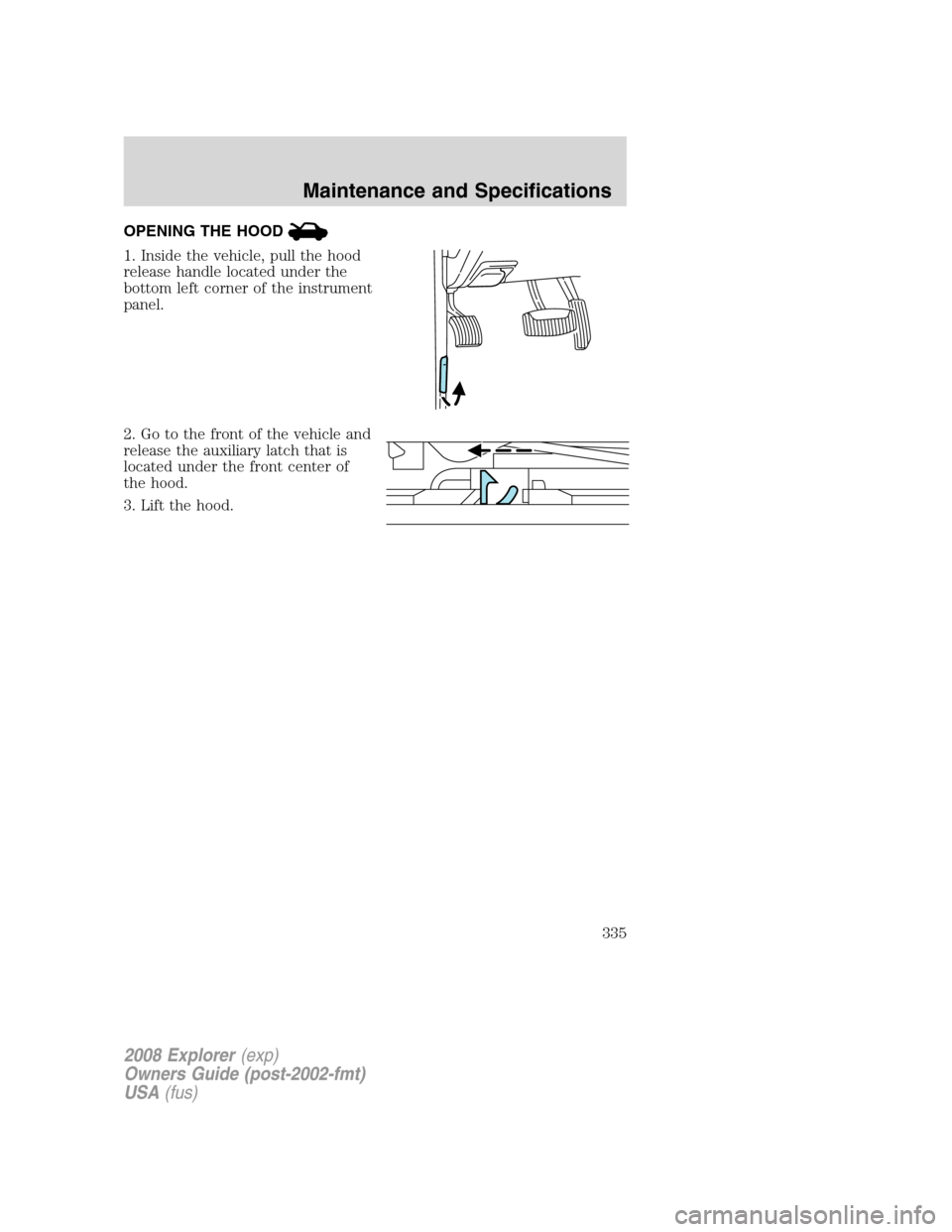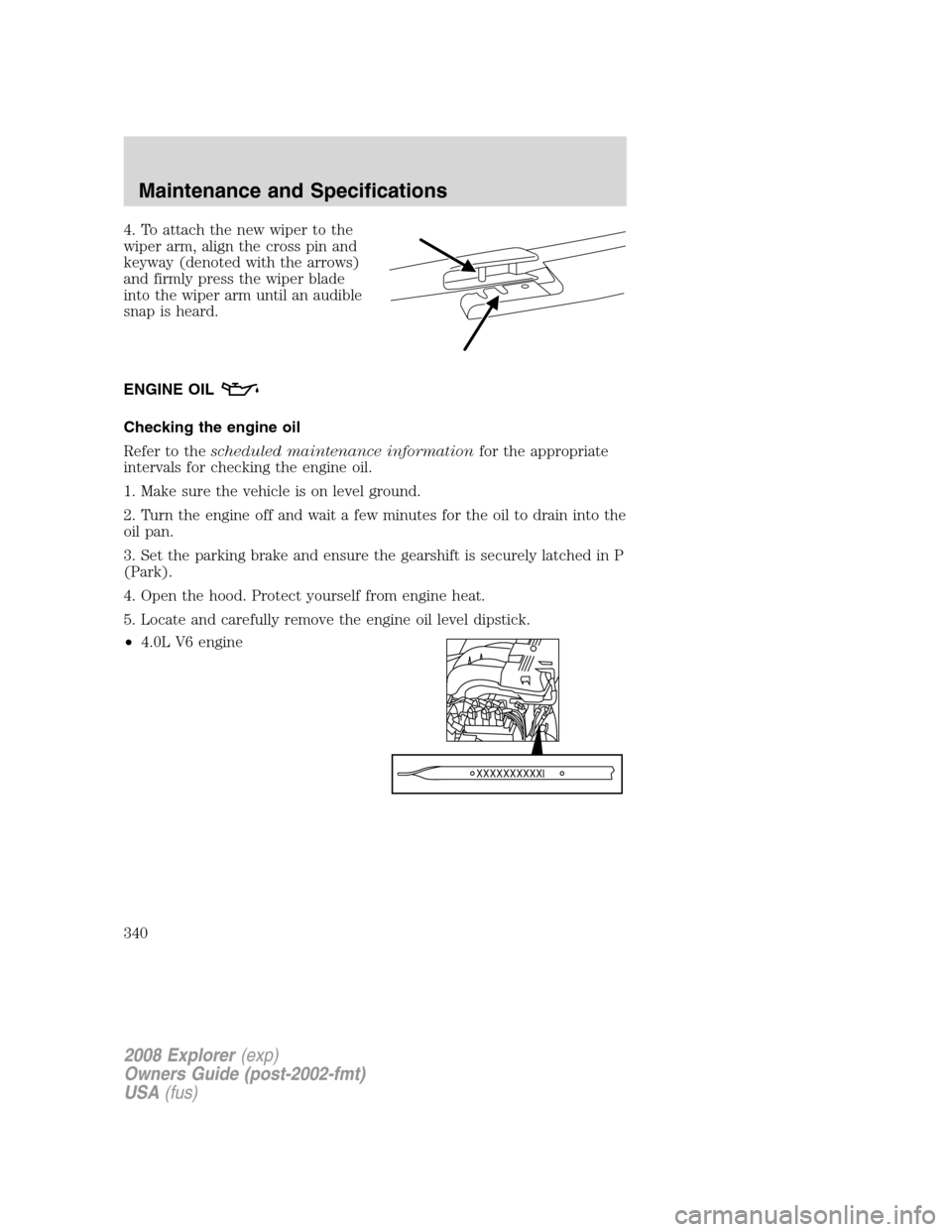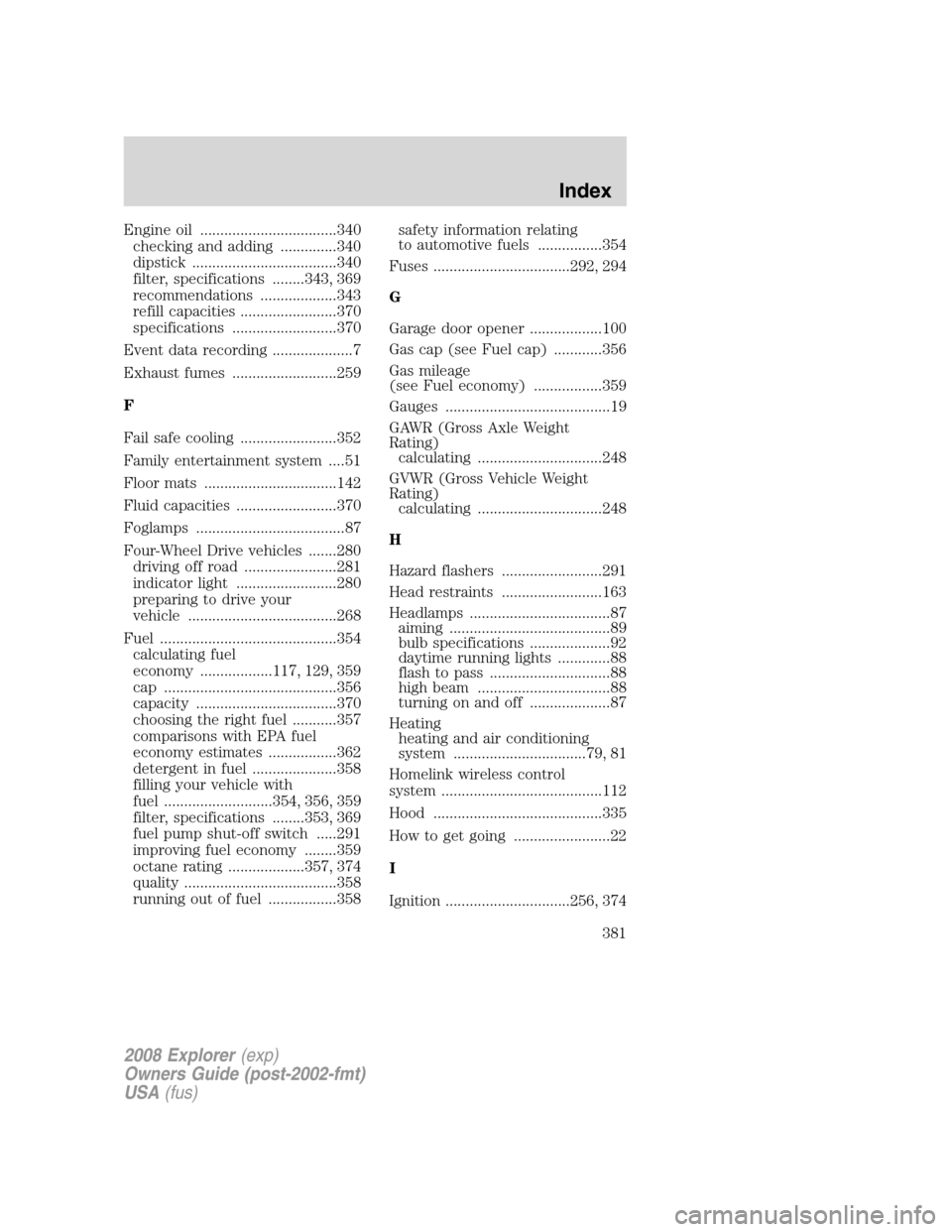2008 FORD EXPLORER open hood
[x] Cancel search: open hoodPage 90 of 384

•(1) Eight feet
•(2) Center height of lamp to
ground
•(3) Twenty-five feet
•(4) Horizontal reference line
2. The center of the headlamp has a
3.0 mm circle on the lens. Measure
the height from the center of your
headlamp to the ground (2) and
mark an 8 foot (2.4 meter) long
horizontal line on the plain surface (1) at this height (masking tape
works well).
3. Turn on the low beam headlamps.
The brightest part of the light
should be below the horizontal line
(4). If it is above the line the
headlamp will need to be adjusted.
4. Open the hood.
5. Locate the vertical adjuster for
each headlamp. Adjust the aim by
turning the adjuster control either
clockwise (to adjust down) or
counterclockwise (to adjust up).
Note:Usea4mmsocket or box
wrench to turn the vertical adjuster
control.
6. Horizontal aiming is not required
for this vehicle and is
non-adjustable.
2008 Explorer(exp)
Owners Guide (post-2002-fmt)
USA(fus)
Lights
90
Page 93 of 384

Function Number of bulbs Trade number
Rear license plate
lamps2
168
Front fog lamp 2 9145
Cargo lamp 1 211-2
Interior overhead lamp 1 912 (906)
Front door courtesy
lamp1
168
Map lamps 2 168 (T10)
Ashtray lamp 1 161
All replacement bulbs are clear in color except where noted.
To replace all instrument panel lights - see your authorized dealer .
Replacing exterior bulbs
Check the operation of all the bulbs frequently.
Replacing the interior bulbs
Check the operation of the bulbs frequently. To replace any of the
interior bulbs, see a dealer or qualified technician.
Replacing headlamp bulbs
Do not touch the glass of a halogen bulb.
1. Turn off the headlamps and open
the hood.
2. Remove three screws from the
headlamp assembly and pull
headlamp forward.
2008 Explorer(exp)
Owners Guide (post-2002-fmt)
USA(fus)
Lights
93
Page 94 of 384

3. Disconnect the electrical
connector.
4. Remove the old bulb by turning
counterclockwise and pull it out.
Handle a halogen headlamp bulb carefully and keep out of
children’s reach. Grasp the bulb only by its plastic base and do
not touch the glass. The oil from your hand could cause the bulb to
break the next time the headlamps are operated.
Reverse steps to reinstall bulb(s).
Replacing front parking lamp/turn signal/sidemarker bulbs
1. Turn off the headlamps and open
the hood.
2. Remove three screws from the
headlamp assembly and pull
headlamp forward.
3. Rotate the bulb socket
counterclockwise and remove it
from the lamp assembly.
4. Pull the bulb straight out of the
socket.
Reverse steps to reinstall bulb(s).
2008 Explorer(exp)
Owners Guide (post-2002-fmt)
USA(fus)
Lights
94
Page 205 of 384

•Roll over sensor in the restraints control module (RCM).
The Safety Canopy™ system, in combination with safety belts, can help
reduce the risk of severe injuries in the event of a significant side impact
collision or rollover event.
Children 12 years old and under should always be properly restrained in
the second or third row seats (if equipped). The Safety Canopy™ will
not interfere with children restrained using a properly installed child or
booster seat because it is designed to inflate downward from the
headliner above the doors along the side window openings.
The Safety Canopy™ system is designed to activate when the vehicle
sustains lateral deceleration sufficient to cause the side crash sensor to
close an electrical circuit that initiates Safety Canopy™ inflation or when
a certain likelihood of a rollover event is detected by the rollover sensor.
The Safety Canopy™ is mounted to the roof side-rail sheet metal, behind
the headliner, above the first and second row seats. In certain lateral
collisions or rollover events, the Safety Canopy™ system will be activated,
regardless of which seats are occupied. The Safety Canopy™ is designed to
inflate between the side window area and occupants to further enhance
protection provided in side impact collisions and rollover events.
The fact that the Safety Canopy™ system did not activate in a collision
does not mean that something is wrong with the system. Rather, it means
the forces were not of the type sufficient to cause activation. The Safety
Canopy™ is designed to inflate in certain side impact collisions or rollover
events, not in rear impact, frontal or near-frontal collisions, unless the
collision causes sufficient lateral deceleration or rollover likelihood.
Several Safety Canopy™ system components get hot after
inflation. Do not touch them after inflation.
If the Safety Canopy™
system has deployed,the
Safety Canopy™ will not
function again. The Safety
Canopy™ system (including
the A, B and C pillar trim)
must be inspected and serviced
by an authorized dealer.If the
Safety Canopy™ is not replaced,
the unrepaired area will increase
the risk of injury in a collision.
2008 Explorer(exp)
Owners Guide (post-2002-fmt)
USA(fus)
Seating and Safety Restraints
205
Page 335 of 384

OPENING THE HOOD
1. Inside the vehicle, pull the hood
release handle located under the
bottom left corner of the instrument
panel.
2. Go to the front of the vehicle and
release the auxiliary latch that is
located under the front center of
the hood.
3. Lift the hood.
2008 Explorer(exp)
Owners Guide (post-2002-fmt)
USA(fus)
Maintenance and Specifications
335
Page 340 of 384

4. To attach the new wiper to the
wiper arm, align the cross pin and
keyway (denoted with the arrows)
and firmly press the wiper blade
into the wiper arm until an audible
snap is heard.
ENGINE OIL
Checking the engine oil
Refer to thescheduled maintenance informationfor the appropriate
intervals for checking the engine oil.
1. Make sure the vehicle is on level ground.
2. Turn the engine off and wait a few minutes for the oil to drain into the
oil pan.
3. Set the parking brake and ensure the gearshift is securely latched in P
(Park).
4. Open the hood. Protect yourself from engine heat.
5. Locate and carefully remove the engine oil level dipstick.
•4.0L V6 engine
2008 Explorer(exp)
Owners Guide (post-2002-fmt)
USA(fus)
Maintenance and Specifications
340
Page 366 of 384

TRANSMISSION FLUID
Checking automatic transmission fluid
The automatic transmission does not have an underhood transmission
fluid dipstick.
Refer to yourscheduled maintenance informationfor scheduled
intervals for fluid checks and changes. Your transmission does not
consume fluid. However, the fluid level should be checked if the
transmission is not working properly, (i.e., if the transmission slips or
shifts slowly) or if you notice some sign of fluid leakage.
Transmission fluid should be checked and, if required, fluid
should be added by an authorized dealer.
Do not use supplemental transmission fluid additives, treatments or
cleaning agents. The use of these materials may affect transmission
operation and result in damage to internal transmission components.
TRANSFER CASE FLUID (IF EQUIPPED)
Turn off the power running
boards, if equipped, before
working under the vehicle, jacking
or placing any object under the
vehicle. Never place your hand
between the extended running
board and the vehicle. A moving
running board may cause injury.
1. Clean the filler plug.
2. Remove the filler plug and inspect the fluid level.
3. Add only enough fluid through
the filler opening so that the fluid
level is at the bottom of the
opening.
Use only fluid that meets Ford specifications. Refer to theMaintenance
product specifications and capacitiessection in this chapter.
2008 Explorer(exp)
Owners Guide (post-2002-fmt)
USA(fus)
Maintenance and Specifications
366
Page 381 of 384

Engine oil ..................................340
checking and adding ..............340
dipstick ....................................340
filter, specifications ........343, 369
recommendations ...................343
refill capacities ........................370
specifications ..........................370
Event data recording ....................7
Exhaust fumes ..........................259
F
Fail safe cooling ........................352
Family entertainment system ....51
Floor mats .................................142
Fluid capacities .........................370
Foglamps .....................................87
Four-Wheel Drive vehicles .......280
driving off road .......................281
indicator light .........................280
preparing to drive your
vehicle .....................................268
Fuel ............................................354
calculating fuel
economy ..................117, 129, 359
cap ...........................................356
capacity ...................................370
choosing the right fuel ...........357
comparisons with EPA fuel
economy estimates .................362
detergent in fuel .....................358
filling your vehicle with
fuel ...........................354, 356, 359
filter, specifications ........353, 369
fuel pump shut-off switch .....291
improving fuel economy ........359
octane rating ...................357, 374
quality ......................................358
running out of fuel .................358safety information relating
to automotive fuels ................354
Fuses ..................................292, 294
G
Garage door opener ..................100
Gas cap (see Fuel cap) ............356
Gas mileage
(see Fuel economy) .................359
Gauges .........................................19
GAWR (Gross Axle Weight
Rating)
calculating ...............................248
GVWR (Gross Vehicle Weight
Rating)
calculating ...............................248
H
Hazard flashers .........................291
Head restraints .........................163
Headlamps ...................................87
aiming ........................................89
bulb specifications ....................92
daytime running lights .............88
flash to pass ..............................88
high beam .................................88
turning on and off ....................87
Heating
heating and air conditioning
system .................................79, 81
Homelink wireless control
system ........................................112
Hood ..........................................335
How to get going ........................22
I
Ignition ...............................256, 374
2008 Explorer(exp)
Owners Guide (post-2002-fmt)
USA(fus)
Index
381